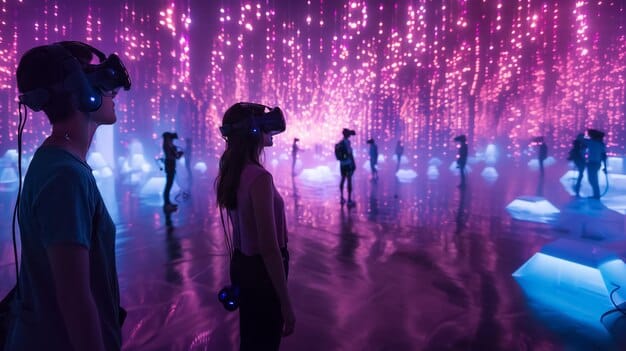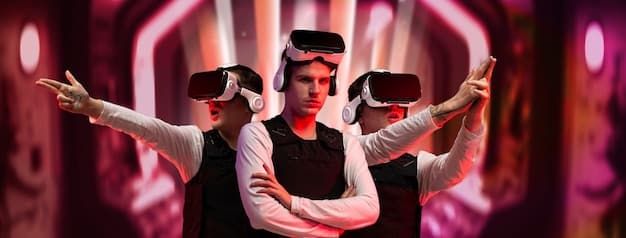Virtual Concerts: The Future of Live Music? Trends & Technologies

The rise of virtual concerts, driven by technological advancements and global events, presents a new frontier in entertainment, offering immersive experiences and broader accessibility, but also raising questions about their long-term viability and impact on the traditional live music industry.
Are virtual concerts here to stay? The convergence of advanced technology and evolving audience expectations has brought virtual concerts into the mainstream, transforming how we experience live music.
What are Virtual Concerts?
Virtual concerts represent a significant evolution in the music industry, offering a digital alternative to traditional live performances. But what exactly defines a virtual concert, and how does it differ from simply watching a recorded show?
Defining the Virtual Concert Experience
A virtual concert is more than just a livestream; it’s an interactive, often immersive, experience that leverages technology to create a sense of presence and engagement for the audience.
- Interactive Elements: Virtual concerts often include chat features, polls, and virtual meet-and-greets, allowing artists to interact with their fans in real-time.
- Immersive Technologies: Many virtual concerts utilize VR, AR, and holographic technologies to create a visually stunning and engaging environment.
- Accessibility: Virtual concerts eliminate geographical barriers, allowing fans from all over the world to attend the same show.
The appeal of virtual concerts lies in their ability to blend the excitement of live music with the convenience and innovation of digital technology.

The Tech Behind Virtual Concerts
The technological infrastructure powering virtual concerts is complex and constantly evolving. From advanced streaming platforms to cutting-edge visual effects, a variety of technologies are essential for creating a seamless and engaging virtual experience.
Key Technologies Driving Virtual Concerts
Several key technologies are crucial for delivering high-quality virtual concerts, each contributing to different aspects of the experience From platforms to deliver it to people’s individual houses and devices.
- High-Bandwidth Streaming: Platforms like Twitch, YouTube Live, and specialized virtual concert platforms require robust streaming infrastructure to handle high volumes of viewers and ensure low latency.
- Virtual Reality (VR): VR headsets offer immersive, 360-degree concert experiences, allowing viewers to feel like they are actually in the audience.
- Augmented Reality (AR): AR technology overlays digital elements onto the real world, enhancing the visual spectacle of the concert.
These technologies work together to create a virtual concert experience that goes beyond simply watching a performance; they aim to transport the viewer into a digital world where they can feel connected to the music and the artist.
The Appeal of Virtual Concerts: Why Are They Popular?
The popularity of virtual concerts has surged in recent years, driven by a combination of factors. Beyond the obvious convenience and accessibility, virtual concerts offer unique benefits that resonate with a diverse audience.
Virtual concerts have a wider variety of reasons as to why they are popular:
- Accessibility and Convenience: Virtual concerts can be enjoyed from anywhere with an internet connection, eliminating the need for travel and venue logistics.
- Enhanced Interactivity: Many virtual concerts offer interactive features such as live chats, Q&A sessions, and virtual meet-and-greets, fostering a stronger connection between artists and fans.
- Unique Experiences: Virtual concerts often incorporate stunning visuals, special effects, and augmented reality elements, creating a unique and memorable experience.
This combination of accessibility, interactivity, and unique experiences has made virtual concerts an attractive option for music fans of all ages and backgrounds.

The Impact on the Music Industry
The rise of virtual concerts has had a significant impact on the music industry, challenging traditional models and creating new opportunities for artists and fans alike. How are these shifts altering the landscape?
The changes of the music industry can be seen economically and artistically:
Economic Impact
Virtual concerts offer new revenue streams for artists, including ticket sales, merchandise, and sponsorships. They also lower the financial barriers to entry for both artists and fans.
Artistic Impact
Virtual concerts allow artists to experiment with new creative formats and push the boundaries of live performance. They can also reach a wider audience and build their fan base globally
While virtual concerts may not replace traditional live shows entirely, they represent a significant shift in the way music is created, distributed, and experienced.
Challenges and Criticisms
Despite their growing popularity, virtual concerts face several challenges and criticisms. These range from technical limitations to concerns about the overall experience
There are reasons as to why virtual concerts can be challenging. Here are a few:
- Technical Issues: Poor internet connections, glitches, and technological barriers can disrupt the viewing experience.
- Lack of Emotional Connection: Some critics argue that virtual concerts lack the emotional intensity and shared experience of live performances.
- Monetization Challenges: Determining fair pricing models and preventing piracy remain significant challenges.
Addressing these challenges will be crucial for the continued growth and acceptance of virtual concerts.
Future Trends in Virtual Concerts
The future of virtual concerts is likely to be shaped by ongoing technological advancements and evolving audience expectations. Several key trends are already emerging, pointing toward a more immersive, interactive, and personalized concert experience.
Expectations from virtual concerts are continuing to grow. The future will hold:
Enhanced Immersive Experiences
Expect to see greater integration of VR, AR, and holographic technologies. These will provide viewers with more realistic and engaging concert experiences.
Personalized Concerts
AI and data analytics will enable personalized concert experiences, tailoring the setlist, visual effects, and interactive elements to individual viewers’ preferences.
Integration with Other Entertainment Formats
Virtual concerts may increasingly integrate with other digital entertainment formats, such as gaming, social media, and e-commerce, creating richer and more diverse experiences.
These trends suggest a future where virtual concerts become an integral part of the music industry, offering fans new and exciting ways to connect with their favorite artists.
| Key Point | Brief Description |
|---|---|
| 🎉 Accessibility | Virtual concerts break geographical barriers for worldwide access. |
| 💻 Technology | VR, AR, and high-bandwidth streaming enhance the viewing experience. |
| 📈 Industry Impact | New revenue streams and creative formats emerge for artists. |
| 🤔 Challenges | Technical issues and lack of emotional connection need addressing. |
FAQ
▼
A virtual concert is a live music performance experienced through digital technology, often incorporating interactive and immersive elements beyond traditional live streams, like VR and AR.
▼
Virtual concerts offer accessibility from anywhere with internet access, often include interactive features like live chats, and may incorporate enhanced visuals and special effects not possible in physical venues.
▼
Key technologies include high-bandwidth streaming, virtual reality (VR), augmented reality (AR), and interactive platforms that facilitate real-time communication and engagement between artists and fans.
▼
Challenges include potential technical issues like poor internet connections, ensuring a strong emotional connection between performers and audiences, and effectively monetizing virtual events while preventing piracy.
▼
The future may bring more personalized concert experiences using AI, deeper integration with VR/AR, and hybrid models combining virtual and live elements, offering fans new ways to engage with music.
Conclusion
In conclusion, virtual concerts represent a dynamic shift in the entertainment landscape. While challenges remain, the integration of cutting-edge technology and the demand for accessible, interactive experiences suggest that virtual concerts are poised to play a significant role in the future of live music.





